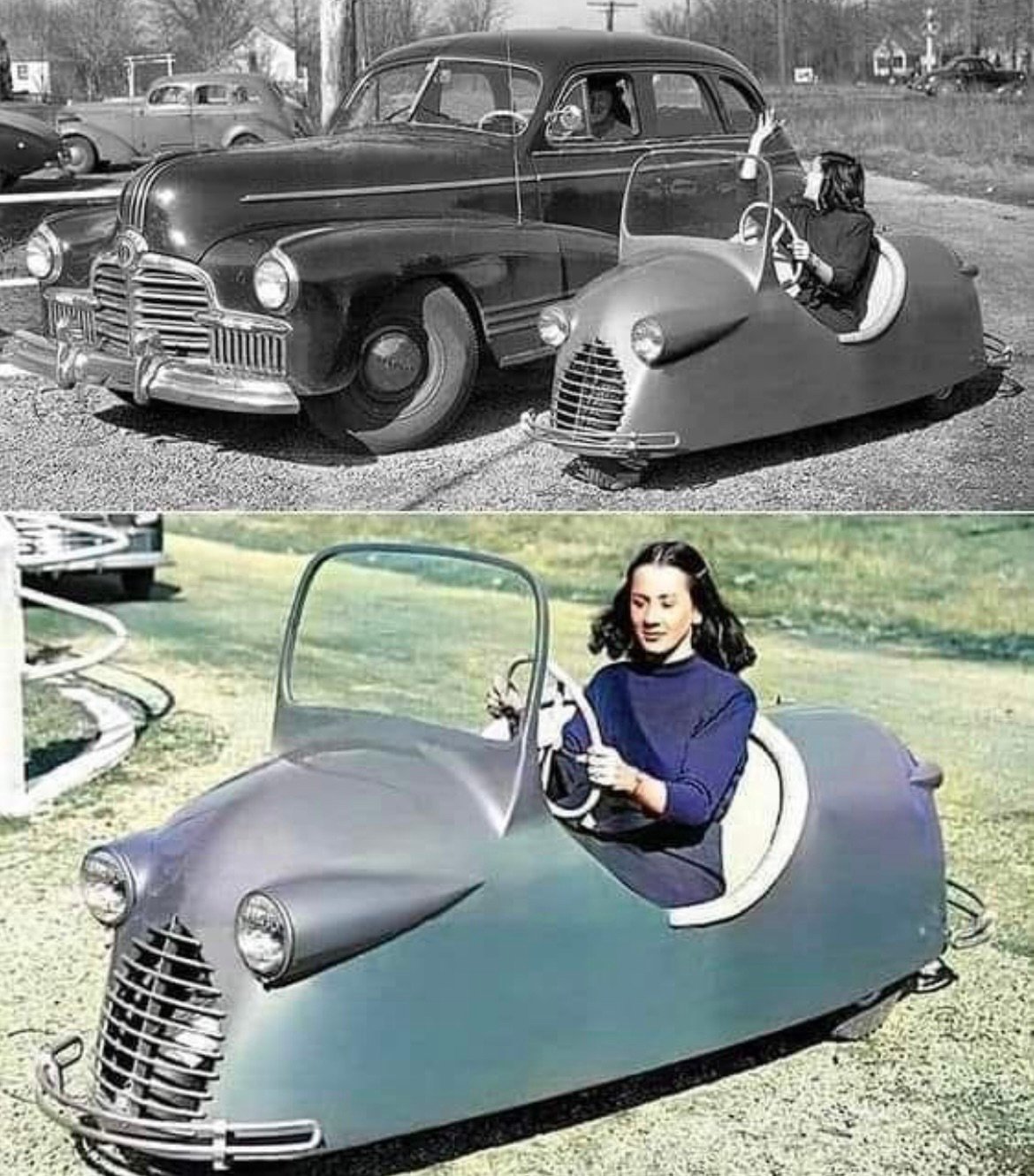The Birth of the Brogan Doodlebug
In the annals of automotive history, the story of the 1944 Brogan Doodlebug holds a special place, capturing the imagination of enthusiasts and historians alike. At a time when the world was engulfed in the throes of World War II, the creation of the Doodlebug was not just an achievement in engineering but a testament to innovation during times of scarcity. Let’s delve into the origins of this remarkable vehicle, exploring how it came to be and the impact it had on the era it graced.

A Vision of Practicality and Efficiency
The Brogan Doodlebug emerged from a vision to create a vehicle that was both practical and efficient, catering to the needs of a population that was increasingly mobile yet constrained by the economic and material shortages of wartime. With a modest 10 horsepower engine, the Doodlebug was not designed to break speed records or dazzle with luxury. Instead, its allure lay in its simplicity and the promise of reliability.
Design and Manufacturing
Crafted with ingenuity, the Doodlebug’s design was straightforward, focusing on essential functions without the frills that characterized other vehicles of the time. Its engine, small but mighty, was capable of propelling the vehicle to a top speed of 45 mph—a remarkable feat considering its size and the technology of the era. The choice of materials and components reflected the resourcefulness of its creators, who managed to produce a vehicle that was both durable and economical.
Meeting the Needs of the Times
The Doodlebug was more than just a vehicle; it was a solution to the mobility challenges faced by many Americans during the war. Its affordability and efficiency made it accessible to a wide audience, from farmers needing to navigate their fields to families seeking a reliable mode of transportation for everyday needs. The Doodlebug’s adaptability to various tasks and environments further cemented its status as a versatile and indispensable tool.
A Legacy of Innovation
The creation of the 1944 Brogan Doodlebug is a story of innovation born out of necessity. It showcases the ability of individuals to think creatively and solve problems with limited resources. The Doodlebug’s legacy is not merely in the vehicle itself but in the spirit of ingenuity and resilience it represents. As we look back on this chapter of automotive history, we are reminded of the power of innovation to drive progress, even in the most challenging times.
The Brogan Doodlebug, with its modest engine and top speed of 45 mph, may not have been the fastest or most luxurious vehicle of its time, but it was undoubtedly one of the most impactful. Its story is a fascinating glimpse into a period when the constraints of war gave rise to remarkable feats of engineering and design, leaving an indelible mark on the history of transportation.
Engineering Behind the Speed
The 1944 Brogan Doodlebug’s remarkable ability to reach a top speed of 45 mph with just a 10 hp engine is a fascinating study in efficiency and design. But what engineering feats allowed this modest powerhouse to achieve such performance? And how does it compare to the technological innovations of its time? Let’s dive into the mechanical wizardry behind the Doodlebug and explore how it stood out in an era defined by both limitations and breakthroughs.
Simplicity Meets Efficiency
At the heart of the Doodlebug’s design was a commitment to simplicity. Without the complexity of modern vehicles, every component had to serve a dual purpose, contributing both to the vehicle’s functionality and its efficiency. The engine, though small, was optimized for maximum output, demonstrating that power can come in compact packages.
The Role of Aerodynamics
Despite the era’s limited understanding of aerodynamics compared to today’s standards, the Doodlebug’s shape was intuitively designed to cut through the air with minimal resistance. This streamlined design not only contributed to its top speed but also reduced fuel consumption, making the Doodlebug an economical choice for its time.
Innovations in Material Use
The use of lightweight materials was crucial in enhancing the Doodlebug’s performance. By minimizing the vehicle’s weight, the designers ensured that the engine’s power was utilized as efficiently as possible, propelling the vehicle to speeds that were impressive for its engine size.
Comparing Technologies of the Time
To fully appreciate the Doodlebug’s innovation, it’s helpful to consider other technological advancements of the era. For instance, the 1980s saw a significant shift in consumer products, including the era of glass soft drink bottles. While seemingly unrelated, the transition from glass bottles to more efficient packaging parallels the Doodlebug’s emphasis on innovation and practicality. Both represent responses to the demands and constraints of their times, pushing the boundaries of what was considered possible.
A Legacy of Ingenuity
The engineering behind the 1944 Brogan Doodlebug’s speed is a testament to the ingenuity of its creators. Faced with the challenges of wartime resource scarcity, they managed to construct a vehicle that was not only practical but also capable of remarkable speed. This blend of efficiency, design, and performance underlines the Doodlebug’s place in automotive history as a symbol of creative problem-solving.
As we reflect on the Doodlebug’s contributions to the world of transportation, it’s clear that its legacy extends beyond its speed or design. It stands as a reminder of how innovation can thrive even in the most challenging circumstances, inspiring future generations to look beyond conventional limitations and strive for breakthroughs that redefine the possible.
Why Don’t We See the Brogan Doodlebug on Today’s Roads?
The Brogan Doodlebug, despite its innovative design and historical significance, has become a rare sight in the modern era. This begs the question: why has such a pioneering vehicle faded into the backdrop of automotive history, especially when it demonstrated such remarkable efficiency and practicality for its time? Let’s explore the factors that contributed to the Doodlebug’s decline and consider what lessons it still offers for the future of transportation.
Technological Evolution and Consumer Demand
One of the primary reasons the Doodlebug isn’t seen on today’s roads is the rapid pace of technological evolution in the automotive industry. As technology advanced, newer vehicles with more powerful engines, enhanced safety features, and improved fuel efficiency entered the market, setting new standards for what drivers expected from their cars. Consumer demand shifted towards these modern conveniences and performance capabilities, leaving vehicles like the Doodlebug, which were designed for a different era, behind.
Regulatory and Safety Standards
As the automobile industry grew, so did the regulatory environment surrounding vehicle safety and emissions. Modern vehicles are subject to rigorous safety standards and environmental regulations that the Doodlebug, designed in the 1940s, was not built to meet. The emphasis on safety features, such as airbags and anti-lock braking systems, and the need to reduce emissions to protect the environment, have shaped the development of new cars, influencing which models are deemed roadworthy today.
Cultural Shifts in Transportation
The way we think about transportation has also evolved since the Doodlebug’s time. There’s been a cultural shift towards viewing cars not just as utilitarian machines but as symbols of status, personal expression, and technological achievement. This shift has influenced the types of vehicles that gain popularity and remain in production. Additionally, the rise of electric vehicles and the push towards sustainable transportation solutions reflect a changing landscape that prioritizes energy efficiency and environmental responsibility over the simpler designs of the past.
Preservation and Collectibility
While the Doodlebug may not be a common sight on modern roads, its legacy lives on through preservation efforts and its status as a collectible item. Enthusiasts and historians recognize the Doodlebug’s importance and strive to keep its memory alive through restoration projects and museum exhibits. These efforts ensure that, even if the Doodlebug isn’t part of our daily commute, it remains a cherished piece of automotive history.
Lessons for the Future
The story of the Brogan Doodlebug reminds us of the importance of innovation, adaptability, and the need to balance practicality with evolving standards and expectations. As we look towards the future of transportation, with a focus on sustainability and efficiency, there’s much to learn from the Doodlebug’s design philosophy. It serves as a testament to the idea that, sometimes, simplicity and functionality can pave the way for meaningful progress
As an Amazon Associate we earn from qualifying purchases through some links in our articles.




